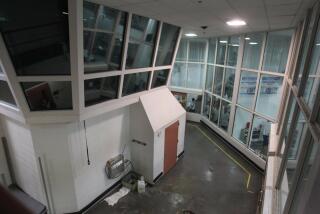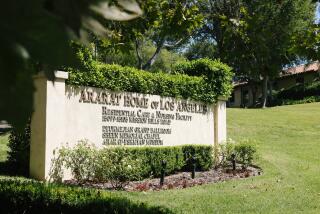King/Drew Patient Monitors Shut Off Following 2 Deaths
- Share via
Martin Luther King Jr./Drew Medical Center is disconnecting a new $411,000 patient monitoring system whose alarms failed to alert nurses this summer that two patients needed urgent attention. The patients -- women ages 33 and 52 -- ultimately died.
The move comes just weeks after the manufacturer and Los Angeles County, which owns the hospital, stressed that a damaged part of the system had been replaced and it could be safely used. The equipment, including 22 bedside monitors, may be reactivated after a county health department investigation.
Relatives of both patients said Tuesday that they had not been told by anyone at the hospital that the monitors did not function as intended. They learned of the problems from a reporter this week.
The nurses “said the monitors were working fine and they showed her heart rate was fine at the time she had the heart attack,” said Ana Lopez, whose 33-year-old sister Sonia died July 4. “How is everything fine if the monitors didn’t alert [nurses]?”
Tuesday’s announcement that the monitors would be pulled offline came on the same day that an accrediting organization was visiting the hospital in Willowbrook, just south of Watts, to determine whether its doctor-training programs should be allowed to continue. Although the review of the facility’s 18 educational programs is unrelated to concerns about the monitors, it comes at an awkward time for a hospital hoping to make a good impression.
While the new monitoring system is being investigated, King/Drew will reinstall the 7-year-old monitors that were in use until June.
The decision to disconnect the new system was made, in part, because nurses were worried that it wasn’t reliable, health officials said.
“The nurses are a little bit jittery about this equipment,” said Laura Sarff, a nurse and director of quality improvement for the county Department of Health Services. “We just need to do some things to assure them and assure us that everything is OK.”
The system was set up so that a central station received information from wireless bedside monitors tracking the blood pressure, heart rate, blood oxygen level and temperature of up to 60 patients. Typically, nurses depended on audible alarms to alert them of patients in distress.
Sarff said she had not received any reports of the monitors malfunctioning since the women died but that experts hired by the county needed to conduct additional tests.
While the deaths remain under investigation, it appears the new system’s alarms did not alert the nurses for different reasons in each patient’s case.
In its investigation of the first incident, which occurred June 30, the monitoring system’s maker, Welch Allyn Inc., found that the alarm at the central station failed to sound because the incorrect identification code had been entered for Lopez, making it appear that another patient’s vital signs were hers.
In the second incident, on July 15, the central alarm may not have sounded because of damage to the main console, a Welch Allyn spokesman said. The company says that damage occurred after installation.
“We stand behind the equipment,” the spokesman, Tom McCall, said. “We don’t believe there was any manufacturing defect that led to either one of the incidents.”
The families of the two women said this week that they were not informed of any sort of monitor problems. In addition, they said doctors had given them no indication that their relatives were near death.
Sonia Lopez entered King/Drew on June 23 with a high fever and a headache, which doctors attributed to meningitis, her sister Ana said. Seven days later, about 1 a.m., she was moved to a bed where a monitor could track her vital signs.
But sometime over the next five hours, Sonia Lopez had a heart attack, her sister said. At 6 a.m., a doctor discovered her and a team resuscitated her. But by the next day, Lopez was brain dead. She died July 4.
“I said, ‘I want to know who was on the night shift.’ I asked why no one saw her between 1 and 6,” said Ana Lopez, who is now helping to care for her sister’s two young children.
Lopez said she asked the nurses why the monitors didn’t alert them and they told her the monitors didn’t show a problem.
In the case of 52-year-old Robbie Bilbrew, her daughters said no one told them that the monitoring system had failed. Bilbrew, a Compton grandmother being treated for pneumonia and diabetes, wasn’t discovered until her doctor made her routine morning rounds, said Cynthia Millage, one of Bilbrew’s daughters.
“She would usually go in and start messing with my mom and say, ‘Hey, Mrs. Bilbrew,’ ” Millage said.
This time, when Bilbrew didn’t respond, the doctor called a team to revive her, but it was too late. “The doctor told me she didn’t know how long she was dead,” said Rona Millage, Bilbrew’s other daughter.
The doctor “was crying and she said, ‘I am so sorry about your mom. I don’t know what happened. She was doing so good,’ ” said Rona Millage.
Bilbrew had been scheduled to leave the hospital for a rehabilitation center the day she died. Rona Millage said she had picked out a muumuu for her mother to wear.
Health department officials said they are looking into why the families were not told about problems with the monitors.
In addition, the health department’s Sarff said she is investigating how the monitors came to be purchased. The hospital’s own nurses had endorsed a different system.
The inquiries are of little comfort to Bilbrew’s daughters.
“That was her first time ever being in the hospital” for an illness, said Cynthia Millage. “And she went into that hospital and never came out.”
More to Read
Sign up for Essential California
The most important California stories and recommendations in your inbox every morning.
You may occasionally receive promotional content from the Los Angeles Times.










